Research on the Durability and Reliability of Industrial Layered Coatings on Metal Substrate Due to Abrasive Wear
Abstract
:1. Introduction
2. Material: Norms and Methodology
3. Results and Discussion
3.1. Coating Structure
3.2. Sliding Friction and Wear
- -
- null—H0: no outliers in the database,
- -
- alternative—Ha—outliers in the database.
4. Summary
- The structure of the coating is fundamental for the durability and reliability of the product. The difference between the coatings is significant, it does not matter a good deal if both are intended for identical applications.
- The abrasion resistance of coatings likely depends on the layered structure of the coatings. The three-layer “black” coating showed higher abrasion resistance.
- Our analysis indicates that the ZA200 (“black”) sheet showed better durability and performance quality.
Funding
Institutional Review Board Statement
Informed Consent Statement
Data Availability Statement
Conflicts of Interest
References
- Przystupa, K.; Pieniak, D.; Samociuk, W.; Walczak, A.; Bartnik, G.; Kamocka-Bronisz, R.; Sutuła, M. Mechanical Properties and Strength Reliability of Impregnated Wood after High Temperature Conditions. Materials 2020, 13, 5521. [Google Scholar] [CrossRef]
- Iwasiewicz, A. Zarządzanie Jakością w Przykładach I zadaniach; Śląskie Wyd. Naukowe: Tychy, Poland, 2005; pp. 27–30. [Google Scholar]
- Przystupa, K. GHP i GMP w Zakładzie Gastronomicznym; Polska Akademia Nauk: Warsaw, Poland, 2007. [Google Scholar]
- Przystupa, K. Wybór punktów krytycznych w systemie HACCP. Przemysł Spożywczy 2013, 67, 42–46. [Google Scholar]
- Wicks, Z.W., Jr.; Jones, F.N.; Pappas, S.P.; Wicks, D.A. Organic Coatings: Science and Technology; Wiley-Interscience: New York, NY, USA, 2007. [Google Scholar]
- Momber, A.W. Quantitative performance assessment of corrosion protection systems for offshore wind power transmission platforms. Renew. Energy 2016, 94, 314–327. [Google Scholar] [CrossRef]
- Godfrey, M.; Siederer, O.; Zekonyte, J.; Barbaros, I.; Wood, R. The effect of temperature on the erosion of polyurethane coatings for wind turbine leading edge protection. Wear 2021, 476, 203720. [Google Scholar] [CrossRef]
- Momber, A.W.; Marquardt, T. Protective coatings for offshore wind energy devices (OWEAs): A review. J. Coatings Technol. Res. 2018, 15, 13–40. [Google Scholar] [CrossRef]
- Souza, J.; Bentes, A.; Reis, K.; Gavinha, S.; Buciumeanu, M.; Henriques, B.; Silva, F.S.; Gomes, J.R. Abrasive and sliding wear of resin composites for dental restorations. Tribol. Int. 2016, 102, 154–160. [Google Scholar] [CrossRef]
- Momber, A.W.; Irmer, M.; Glück, N.; Plagemann, P. Abrasion testing of organic corrosion protection coating systems with a rotating abrasive rubber wheel. Wear 2016, 348–349, 166–180. [Google Scholar] [CrossRef]
- Bello, J.O.; Wood, R.J. Micro-abrasion of filled and unfilled polyamide 11 coatings. Wear 2005, 258, 294–302. [Google Scholar] [CrossRef]
- Wuttke, W. Tribophysik; Carl Hanser Verlag: München, Germany, 1987. [Google Scholar]
- Momber, A.W.; Irmer, M.; Marquardt, T. Effects of polymer hardness on the abrasive wear resistance of thick organic offshore coatings. Prog. Org. Coat. 2020, 146, 105720. [Google Scholar] [CrossRef]
- Pieniak, D.; Przystupa, K.; Walczak, A.; Niewczas, A.M.; Krzyzak, A.; Bartnik, G.; Gil, L.; Lonkwic, P. Hydro-thermal fatigue of polymer matrix composite biomaterials. Materials 2019, 12, 3650. [Google Scholar]
- Abdelbary, A. 8—Prediction of Wear in Polymers and Their Composites; Abdelbary, A., Ed.; Wear of Polymers and Composites; Woodhead Publishing: Soston, UK, 2014; pp. 185–217. [Google Scholar]
- Available online: https://projects.arcelormittal.com/repository/Projects%20CIS/Distribution%20and%20Solar/E30_Steels%20with%20galfan%20zinc-aluminium%20coating_brochure_EN.pdf (accessed on 16 December 2021).
- Available online: https://industry.arcelormittal.com/industry/repository/fce/Brochures/Magnelis (accessed on 8 November 2021).
- EN 10346:2015 [IDT]; Continuously Hot-Dip Coated Steel Flat Products for Cold Forming—Technical Delivery Conditions. British Standards Institution: London, UK, 2015.
- PN-EN 10346:2015-09; Wyroby Płaskie Stalowe Powlekane Ogniowo w Sposób Ciągły do Obróbki Plastycznej na Zimno—Warunki Techniczne Dostawy. PKN: Warsaw, Poland, 2015.
- EN 10169:2022 [IDT]; Continuously Organic Coated (Coil Coated) Steel Flat Products—Technical Delivery Conditions. British Standards Institution: London, UK, 2022.
- PN-EN 10169:2022-08; Wyroby płaskie Stalowe z Powłoką Organiczną Naniesioną w Sposób Ciągły–Warunki Techniczne Dostawy. PKN: Warsaw, Poland, 2022.
- EN 10327:2004; Continuously Hot-Dip Coated Strip and Sheet of Low Carbon Steels for Cold Forming—Technical Delivery Conditions. British Standards Institution: London, UK, 2004.
- Mayer, P.; Dmitruk, A.; Pach, J. Impact and adhesion tests of composite polymer coatings on steel substrate. Compos. Theory Pract. 2018, 18, 156–161. [Google Scholar]
- Przystupa, K. Quality Evaluation of Selected Organic Coatings Used on Roofing Sheets. Materials 2022, 15, 1310. [Google Scholar] [CrossRef]
- Kleczewska, J.; Bieliński, D.M. Friction and wear of resin -based dental materials. Arch. Civ. Mech. Eng. 2007, 7, 87–96. [Google Scholar] [CrossRef]
- Carreira, M.; Anunes, P.V.; Ramahlo, A.L.; Carrihlo, E. Thermocycling effect of mechanical and tribological chracterization of two indirect dental restorative materials. J. Braz. Soc. Mech. Sci. Eng. 2016, 38, 5. [Google Scholar]
- Hill, T.; Lewicki, P. Statistics: Methods and Applications: A Comprehensive Reference for Science, Industry and Data Mining; wyd. StatSoft: Tulsa, OK, USA, 2006. [Google Scholar]
- Sidhom, M.; Zaghloul, H.; Mosleh, I.E.; Eldwakhly, E. Effect of different CAD/CAM milling and 3D printing digital fabrication techniques on the accuracy of PMMA working models and vertical marginal fit of PMMA provisional dental prosthesis: An in vitro study. Polymers 2022, 14, 1285. [Google Scholar] [CrossRef]
- Ling, J.; Pan, J. A maximum likelihood method for estimating P–S–N curves. Int. J. Fatigue 1997, 19, 415–419. [Google Scholar] [CrossRef]
- Almalki, S.; Nadarajah, S. Modifications of the Weibull distribution: A review. Reliab. Eng. Syst. Saf. 2014, 124, 32–55. [Google Scholar] [CrossRef]
- Zhao, Y.; Gao, Q.; Wang, J. An approach for determining an appropriate assumed distribution of fatigue life under limited data. Reliab. Eng. Syst. Saf. 2000, 67, 1–7. [Google Scholar] [CrossRef]
- Yang, C.-W. Development of Hydrothermally Synthesized Hydroxyapatite Coatings on Metallic Substrates and Weibull’s Reliability Analysis of its Shear Strength. Int. J. Appl. Ceram. Technol. 2015, 12, 282–293. [Google Scholar] [CrossRef]
- Niewczas, A.M.; Pieniak, D.; Ogrodnik, P. Reliability analysis of strength of dental composites subjected to different photopolymerization procedures. eksploatacja i Niezawodnosc–Maintenance and Reliability 2012, 14, 249–255. [Google Scholar]
- Barraza-Contreras, J.M.; Piña-Monarrez, M.R.; Molina, A. Fatigue-Life Prediction of Mechanical Element by Using the Weibull Distribution. Appl. Sci. 2020, 10, 6384. [Google Scholar] [CrossRef]
- Kocańda, S.; Szala, J. Basis of Calculation of Fatigue; Wydawnictwo Naukowe PWN: Warszawa, Poland, 1997. [Google Scholar]
- O’Connor, P.; Kleyner, A. Practical Reliability Engineering, 5th ed.; John Wiley and Sons, Ltd.: Hoboken, NJ, USA, 2012; pp. 78–140. [Google Scholar]
- Yang, Y.H.; Wang, K.S. Study of the characteristics about insulation damage based on the accelerated life tests. Eksploatacja i Niezawodność 2013, 15, 325–331. [Google Scholar]
- Johnson, N.L.; Kotz, S.; Balakrishnan, N. Continuous Univariate Distributions, Volume 2; John Wiley & Sons: Hoboken, NJ, USA, 1995; Volume 289. [Google Scholar]
- Chen, C.-L.; Wang, K.-S. A generalized Gompertz model of reliability-dependent hazard rate for composites under cyclic stresses. Sci. Eng. Compos. Mater. 2012, 19, 81–88. [Google Scholar] [CrossRef]
- Makulski, P. Włodzimierz Gogołek, Wiesław Cetera Leksykon tematyczny. Zarządzanie, IT. Stud. Medioznawcze 2014, 58, 184–186. [Google Scholar] [CrossRef]
- Lewin, W.; Hryniewicz, O. Niezawodna jakość. Problemy Jakości 2006, 10, 22–24. [Google Scholar]
- PN-EN ISO 9001:2015-10; Systemy Zarządzania Jakością—Wymagania. PKN: Warsaw, Poland, 2015.



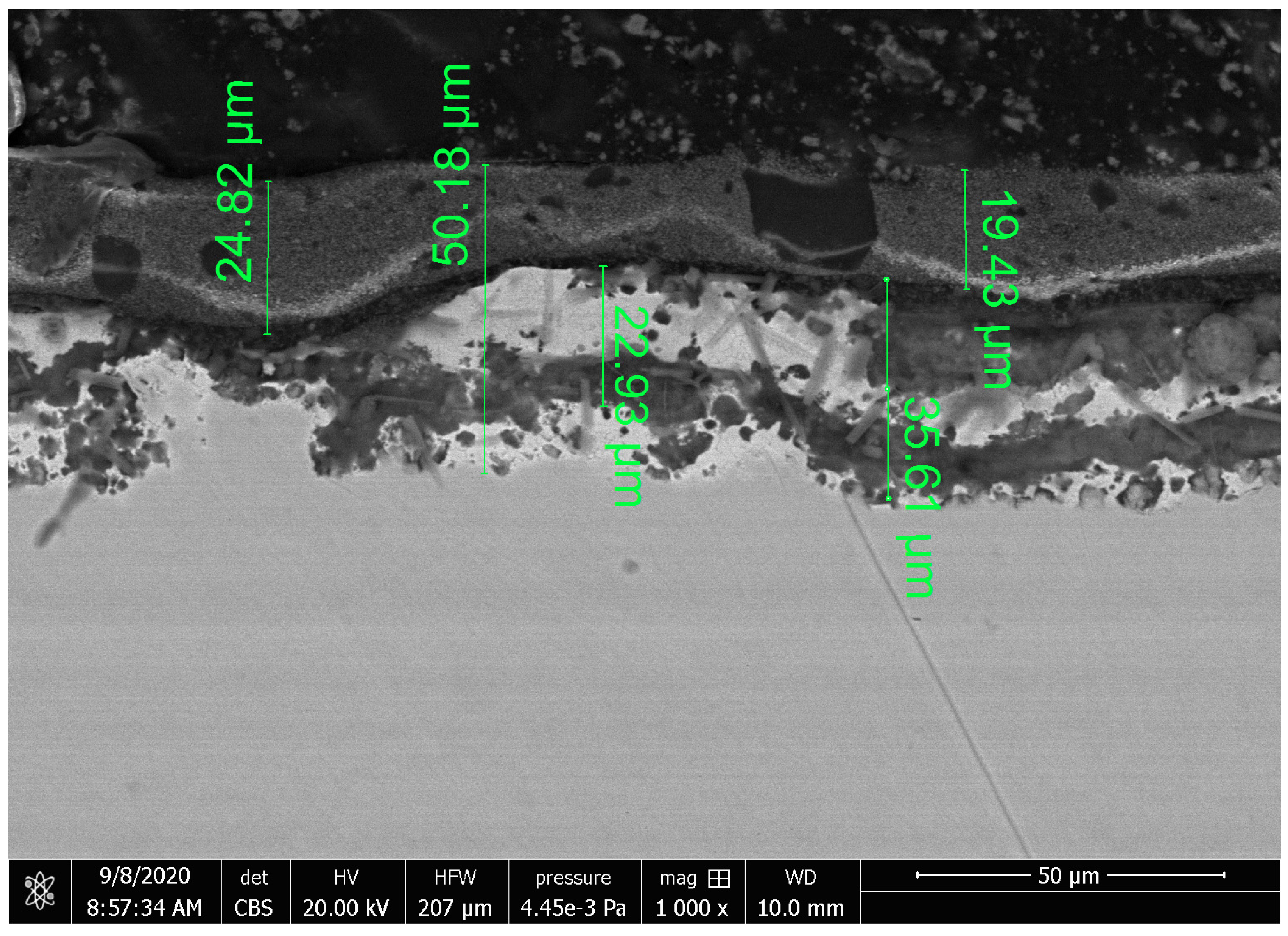
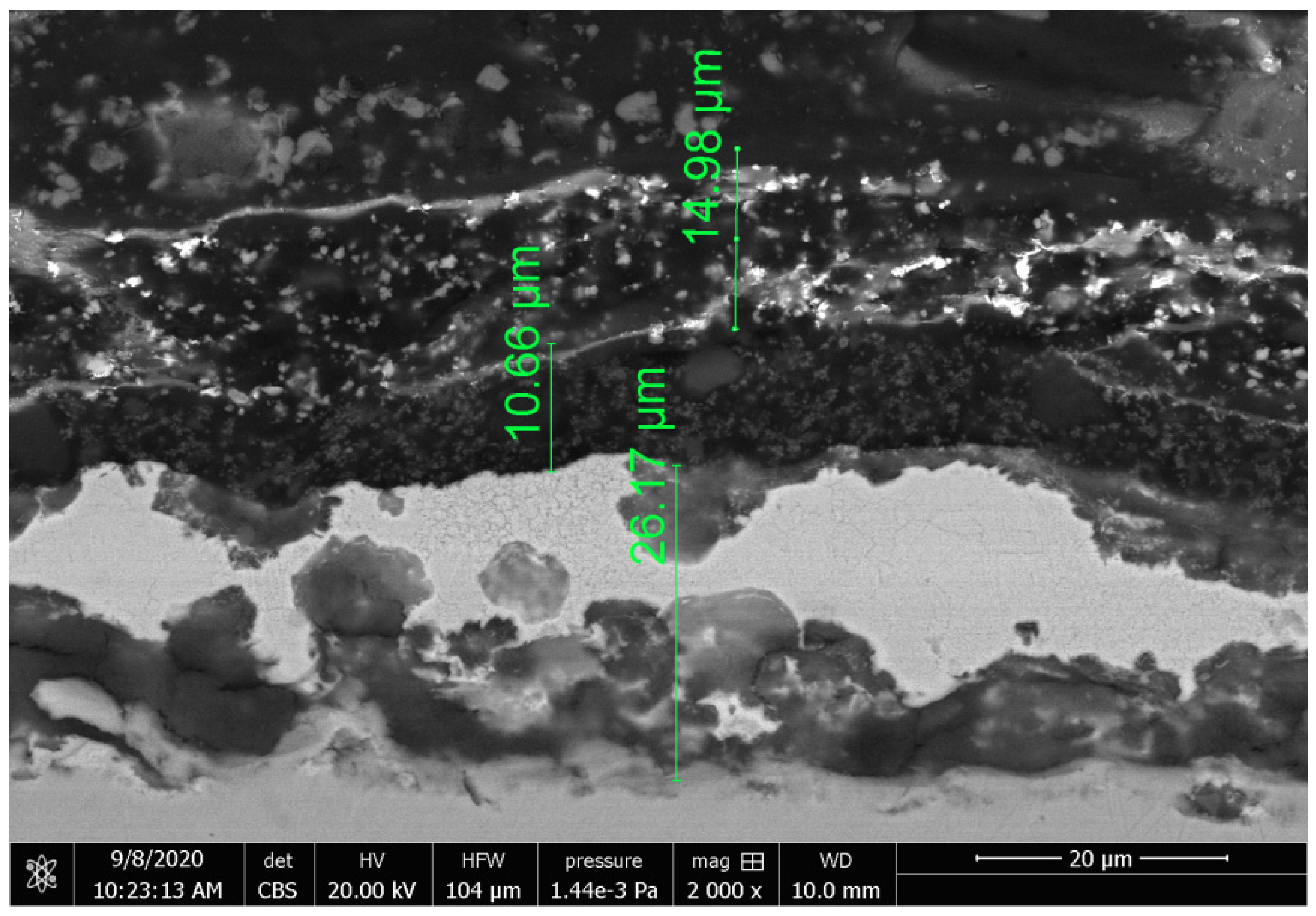
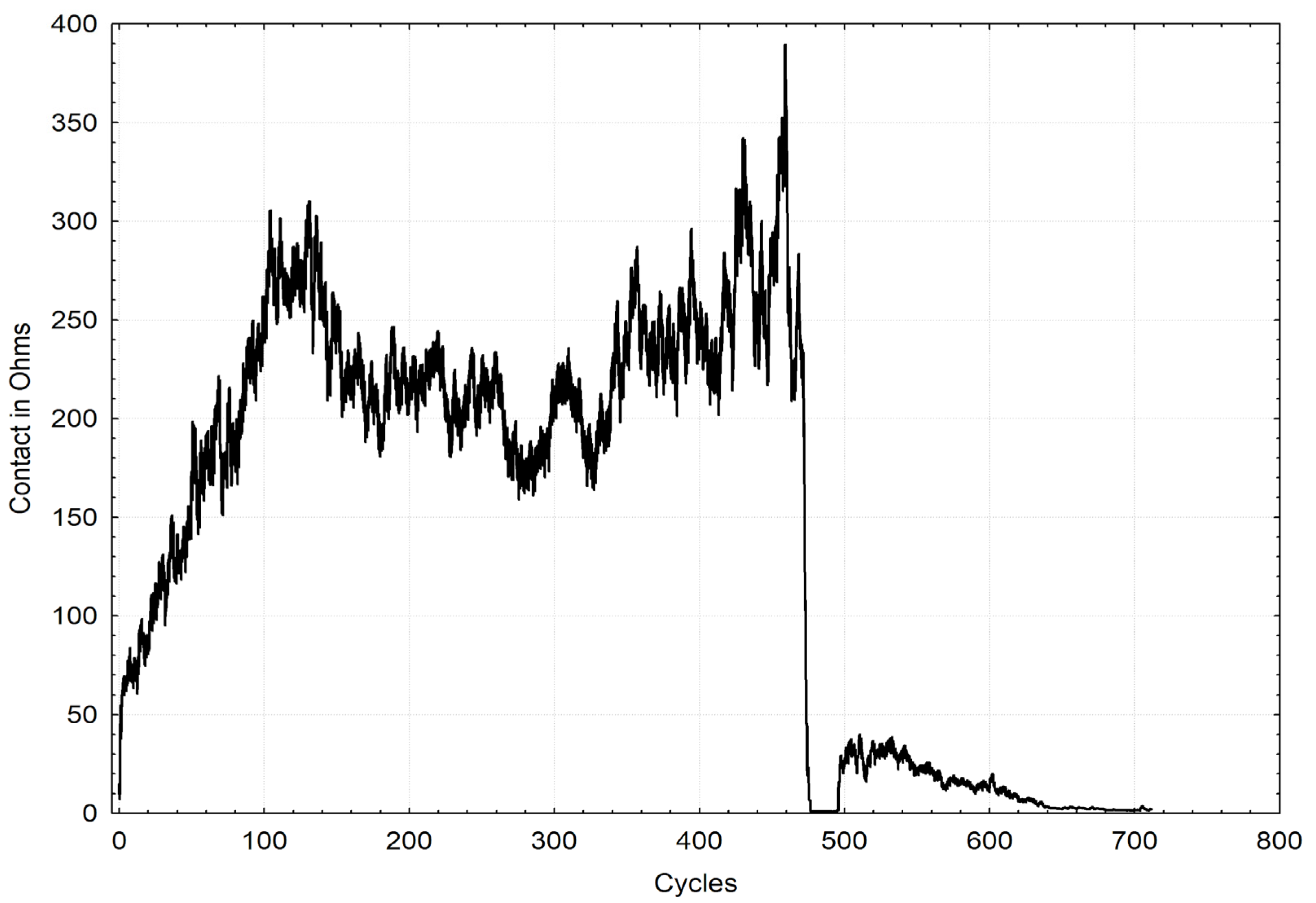
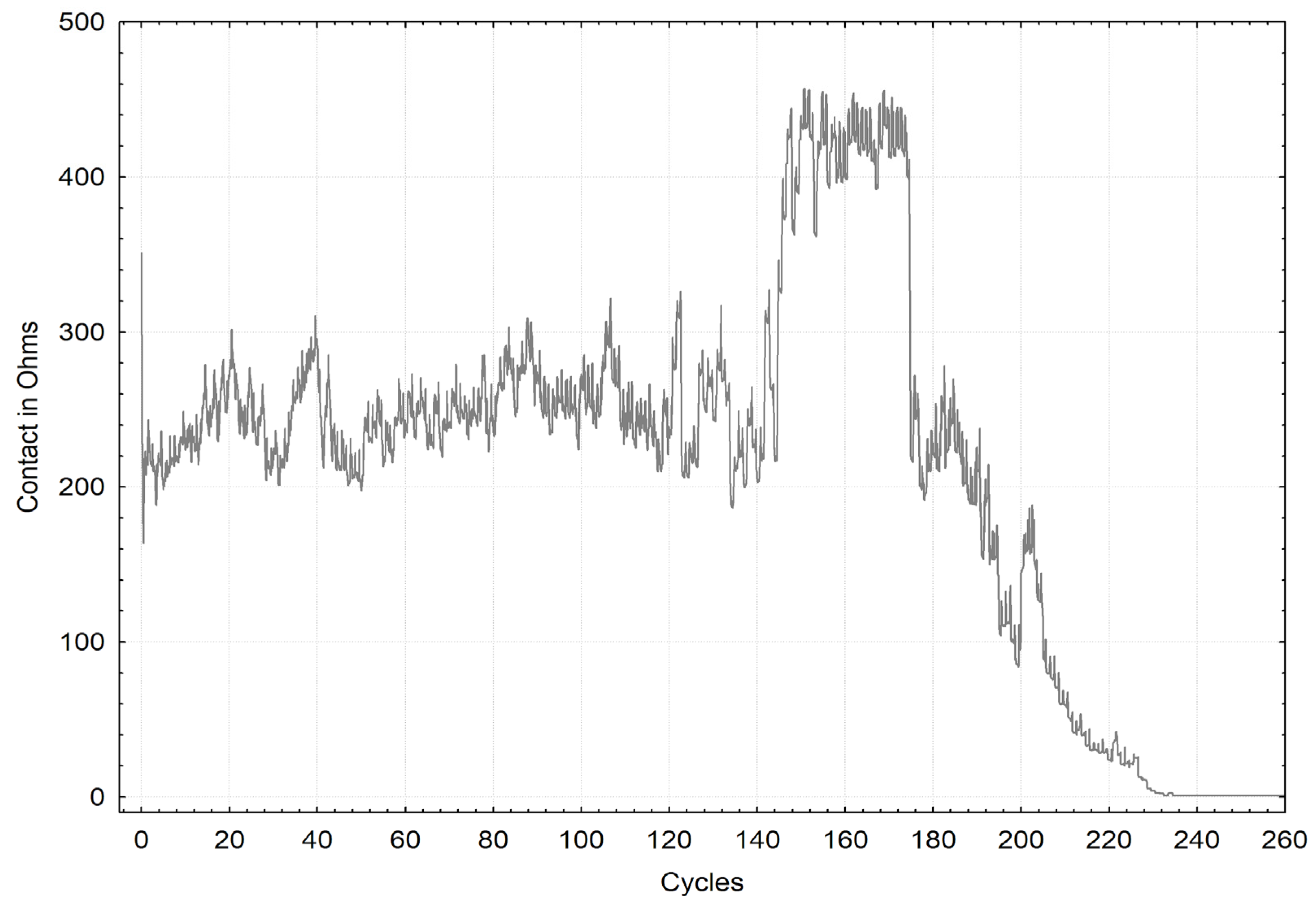
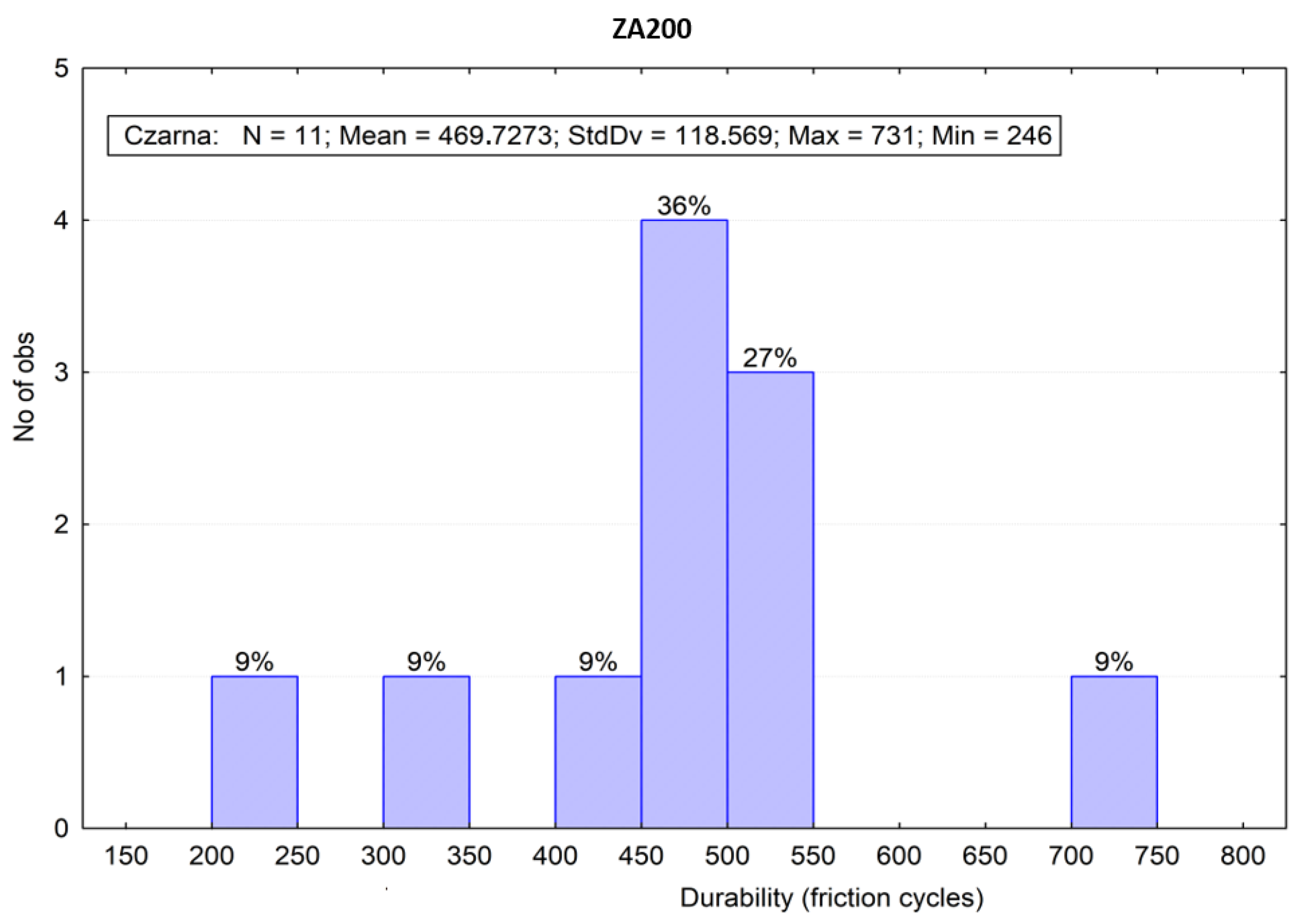
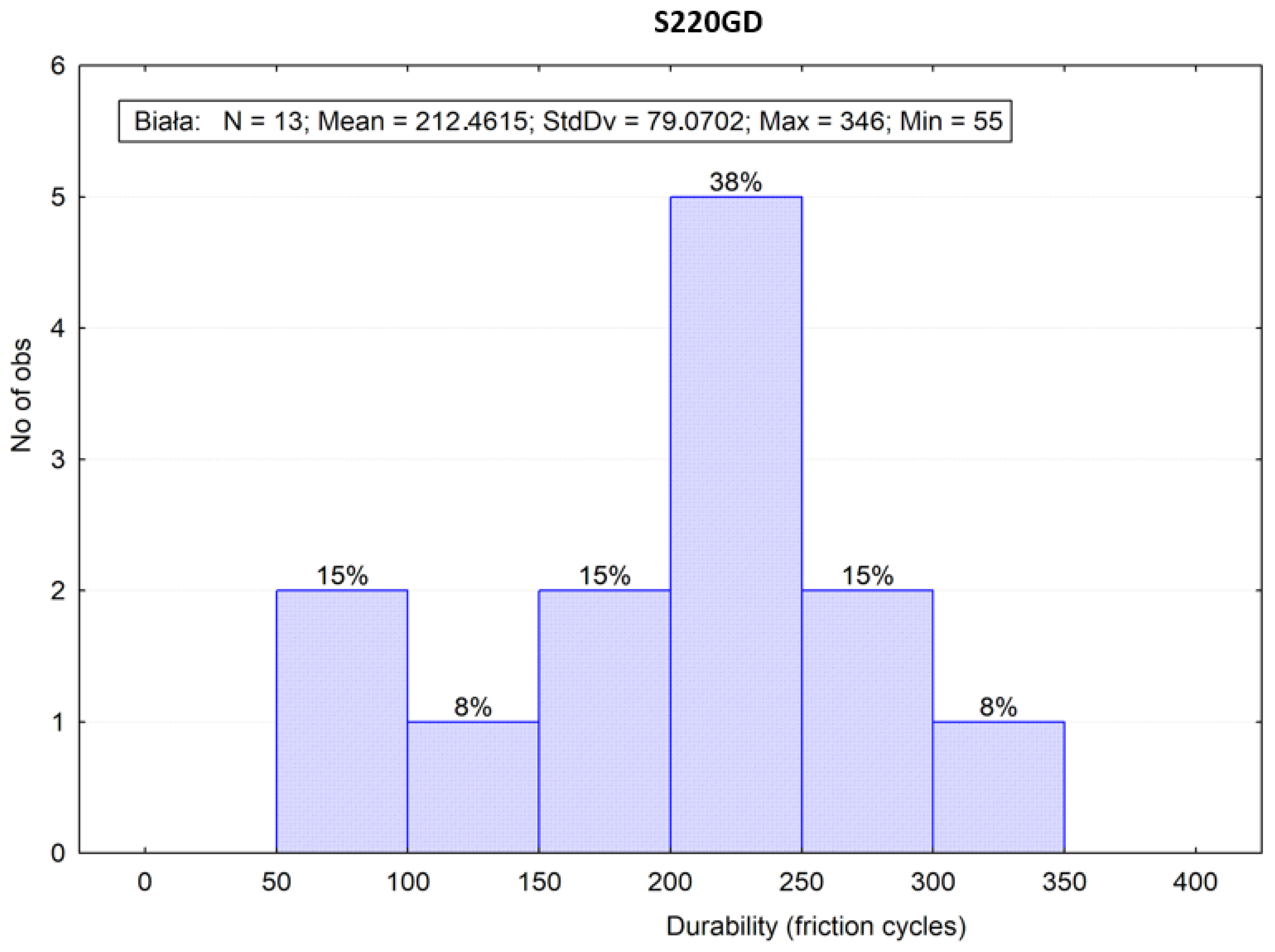
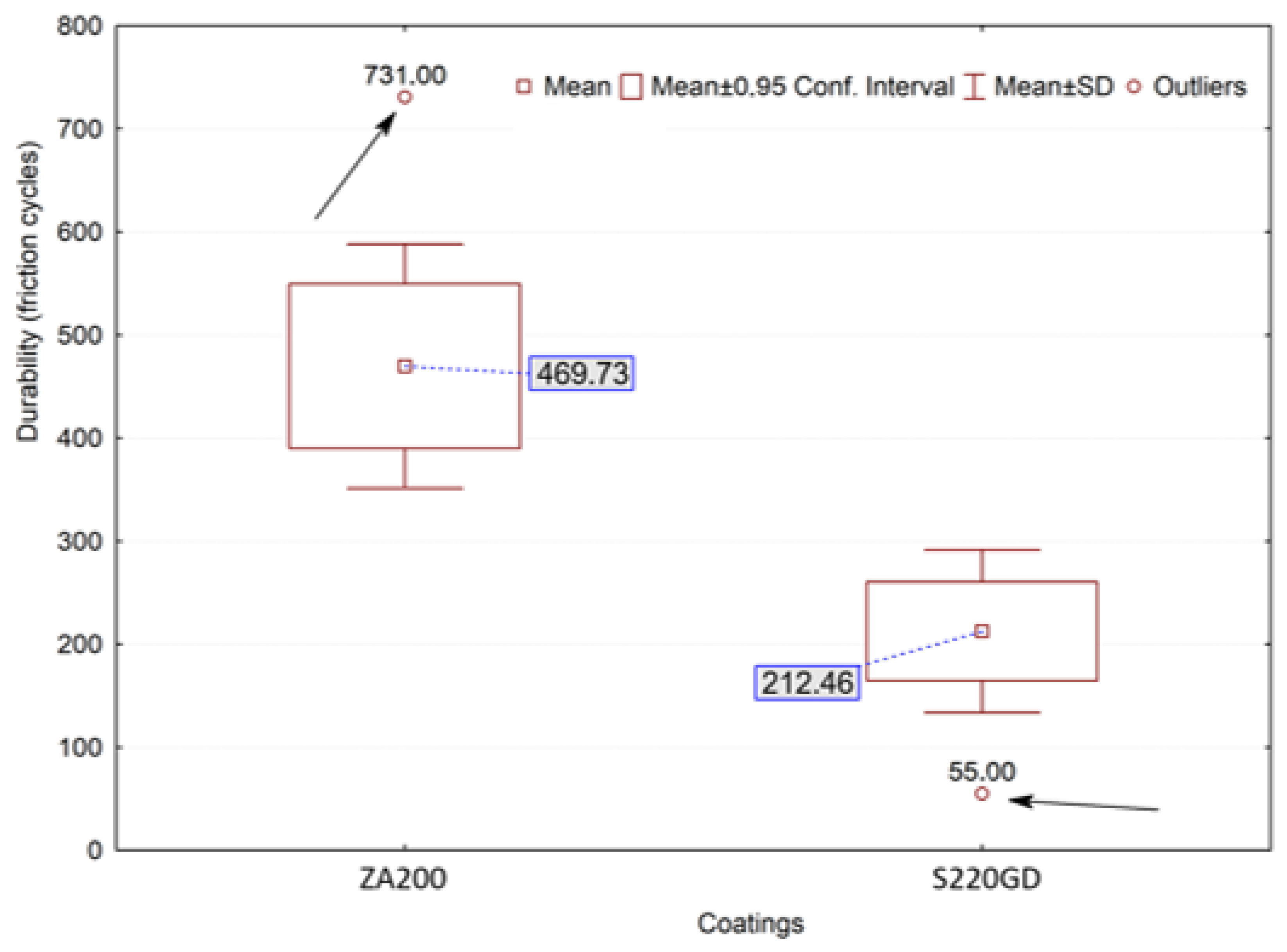



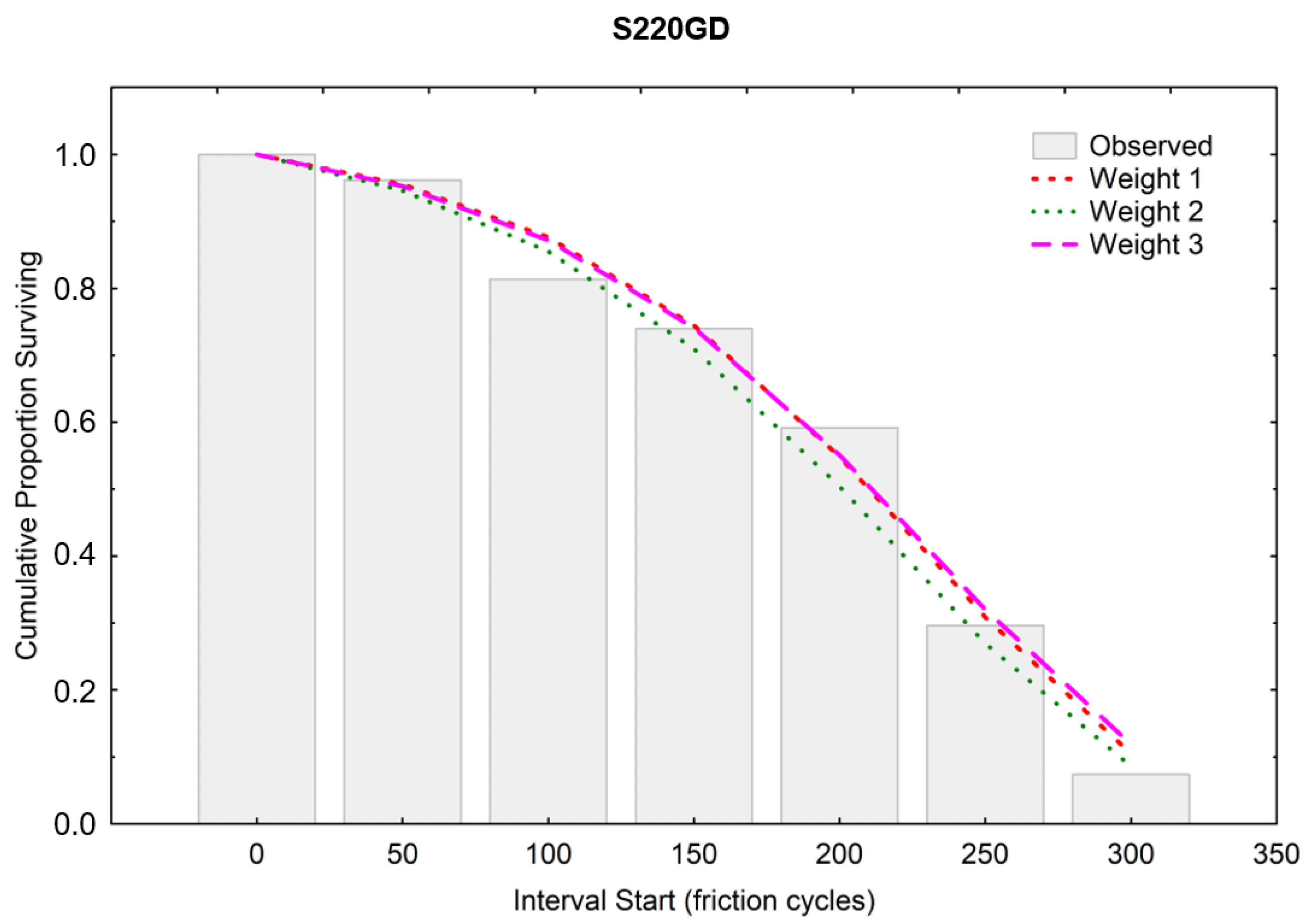
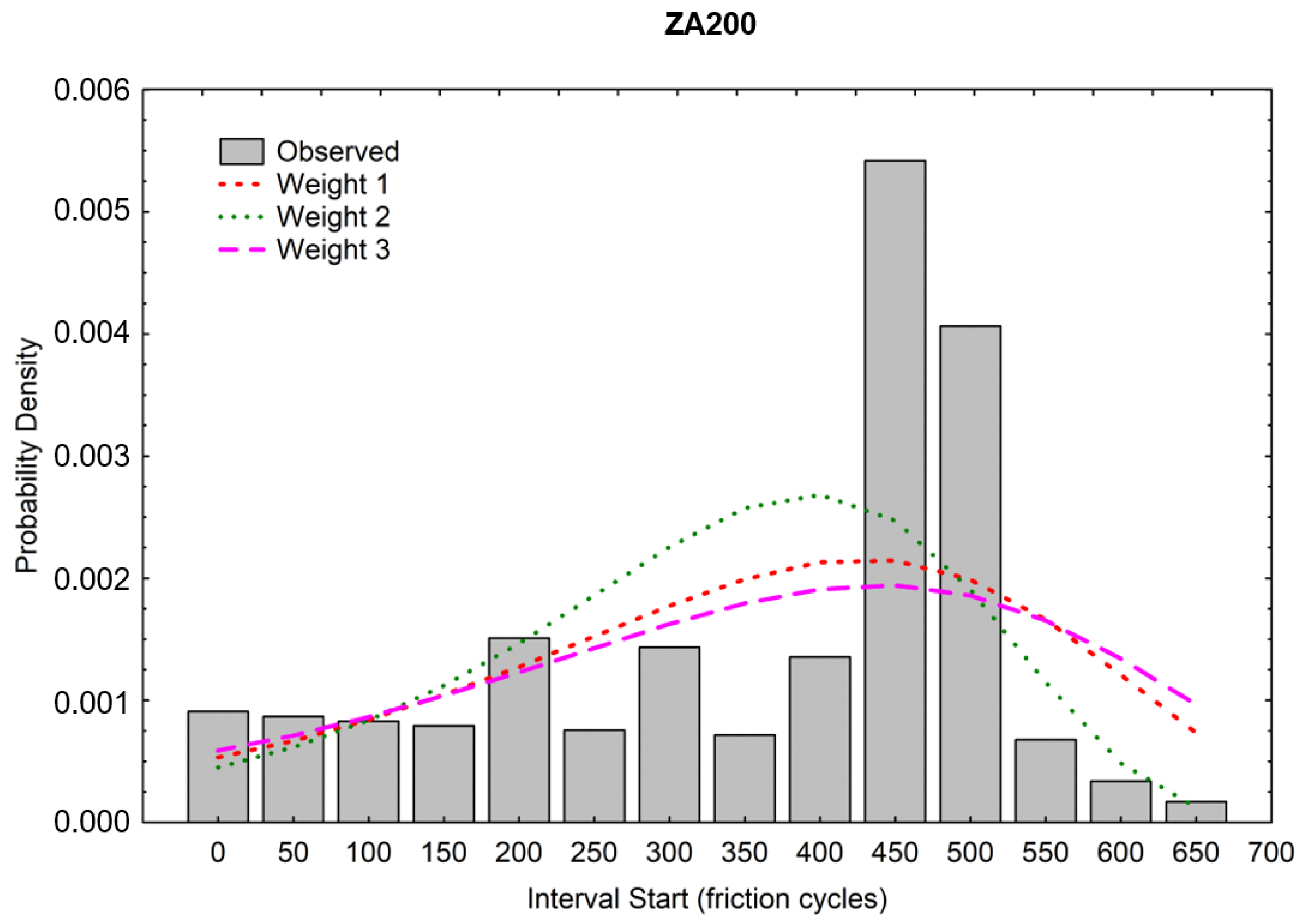


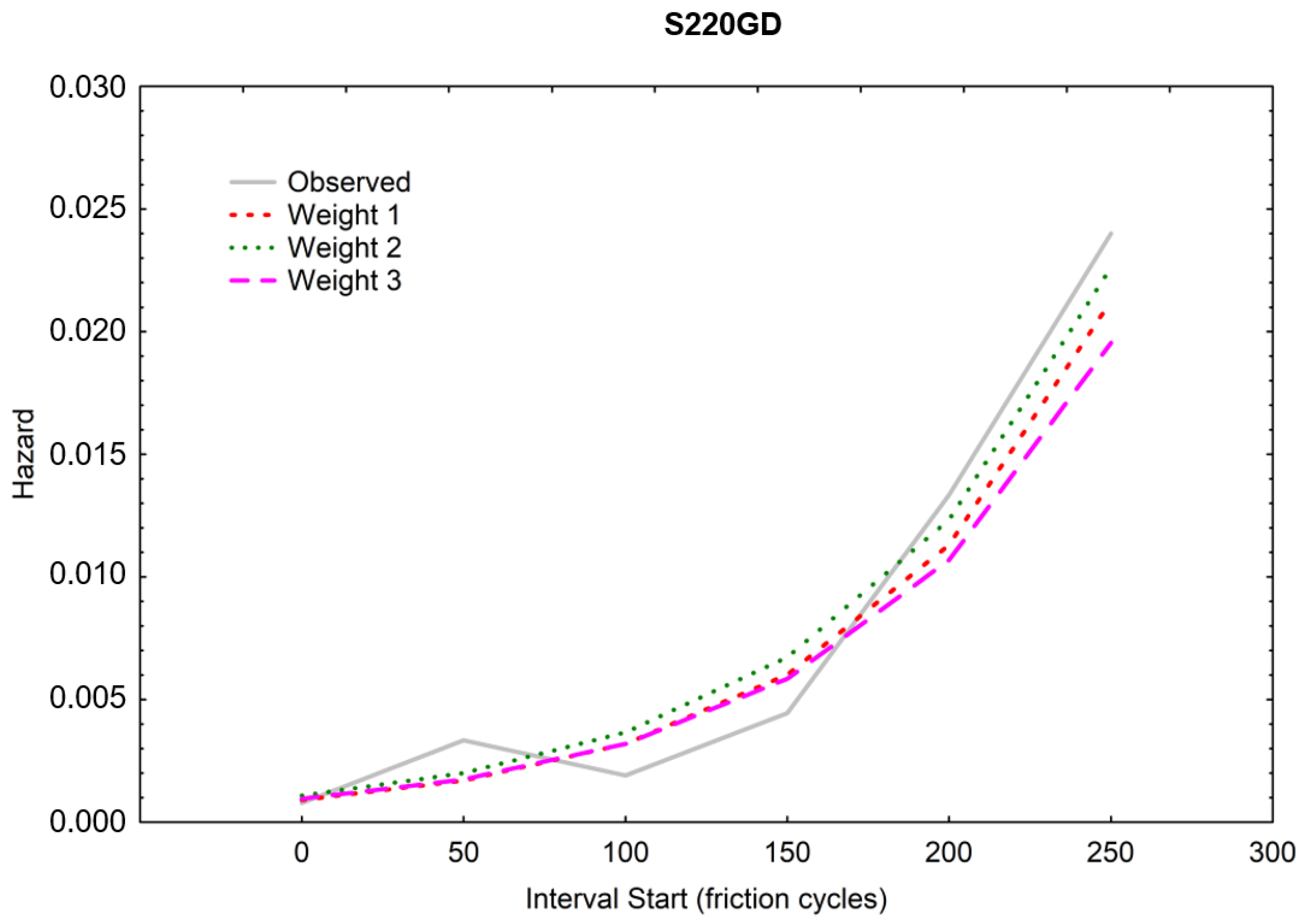
| Coating Designation | Minimum Total Coating Mass, Both Surfaces g/m2 | Theoretical Guidance Values for Coating Thickness Per Surface in the Single-Spot Test, µm | Density g/cm3 | ||
|---|---|---|---|---|---|
| Triple-Spot Test | Single-Spot Test | Typical Value | Range | ||
| Zinc–aluminum alloy coating masses (ZA) | |||||
| ZA095 | 95 | 80 | 7 | 5 to 12 | 6.6 |
| ZA130 | 130 | 110 | 10 | 7 to 15 | |
| ZA185 | 185 | 155 | 14 | 10 to 20 | |
| ZA200 | 200 | 170 | 15 | 11 to 21 | |
| ZA255 | 255 | 215 | 20 | 15 to 27 | |
| Coatings | Trimmed Mean—5.0000% | Winsorized Mean—5.0000% | Grubbs Test— Statistics | p |
|---|---|---|---|---|
| ZA200 | 465.56 | 459.45 | 2.20 | 0.23 |
| S220GD | 214.64 | 211.31 | 1.99 | 0.80 |
| Rank Sum ZA200 | Rank Sum S220GD | U | Z | p |
|---|---|---|---|---|
| 204.0 | 96.0 | 5.0 | 3.852780 | 0.000117 |
Disclaimer/Publisher’s Note: The statements, opinions and data contained in all publications are solely those of the individual author(s) and contributor(s) and not of MDPI and/or the editor(s). MDPI and/or the editor(s) disclaim responsibility for any injury to people or property resulting from any ideas, methods, instructions or products referred to in the content. |
© 2023 by the author. Licensee MDPI, Basel, Switzerland. This article is an open access article distributed under the terms and conditions of the Creative Commons Attribution (CC BY) license (https://creativecommons.org/licenses/by/4.0/).
Share and Cite
Przystupa, K. Research on the Durability and Reliability of Industrial Layered Coatings on Metal Substrate Due to Abrasive Wear. Materials 2023, 16, 1779. https://doi.org/10.3390/ma16051779
Przystupa K. Research on the Durability and Reliability of Industrial Layered Coatings on Metal Substrate Due to Abrasive Wear. Materials. 2023; 16(5):1779. https://doi.org/10.3390/ma16051779
Chicago/Turabian StylePrzystupa, Krzysztof. 2023. "Research on the Durability and Reliability of Industrial Layered Coatings on Metal Substrate Due to Abrasive Wear" Materials 16, no. 5: 1779. https://doi.org/10.3390/ma16051779







